-
Paper Information
- Next Paper
- Paper Submission
-
Journal Information
- About This Journal
- Editorial Board
- Current Issue
- Archive
- Author Guidelines
- Contact Us
International Journal of Genetic Engineering
p-ISSN: 2167-7239 e-ISSN: 2167-7220
2025; 13(9): 173-181
doi:10.5923/j.ijge.20251309.02
Received: Aug. 24, 2025; Accepted: Sep. 16, 2025; Published: Sep. 20, 2025

The Distribution of Astragalus L. (Fabaceae) Species in the Central Fergana Botanical-Geographical District
Ilyosbek Sharipov1, Avazbek Batoshov2, Nodirbek Sharipov3
1PhD Student, Namangan State University, Uzbekistan
2Doctor of Biological Sciences (DSc), Professor, Namangan State University, Uzbekistan
3Teacher, Namangan City Impulse Medical Institute, Uzbekistan
Correspondence to: Ilyosbek Sharipov, PhD Student, Namangan State University, Uzbekistan.
| Email: |  |
Copyright © 2025 The Author(s). Published by Scientific & Academic Publishing.
This work is licensed under the Creative Commons Attribution International License (CC BY).
http://creativecommons.org/licenses/by/4.0/

Ecological change in arid landscapes has elevated the need for rigorous flora assessments and conservation planning. This study evaluates the current status of Astragalus species distributed across the Central Fergana region. Drawing on coordinated field surveys, verified herbarium vouchers, and a synthesis of prior scientific literature, we compile an updated inventory of regional Astragalus taxa. All occurrence records were geo – referenced and visualized in a GIS environment to confirm species identities and delineate distribution areas. The resulting checklist and maps provide a consolidated, evidence-based view of Astragalus diversity and spatial patterns in Central Fergana, offering a practical baseline for future population monitoring, habitat assessments, and conservation prioritization. By integrating ground-based observations with archival sources, the study strengthens regional floristic knowledge and supplies a reproducible framework for assessing other xerophytic plant groups in arid Central Asia.
Keywords: Endemic, Astragalus, Central Fergana, Red Book
Cite this paper: Ilyosbek Sharipov, Avazbek Batoshov, Nodirbek Sharipov, The Distribution of Astragalus L. (Fabaceae) Species in the Central Fergana Botanical-Geographical District, International Journal of Genetic Engineering, Vol. 13 No. 9, 2025, pp. 173-181. doi: 10.5923/j.ijge.20251309.02.
Article Outline
1. Introduction
- Human pressures–especially uncontrolled development and climate change–have intensified the threatened status of numerous plant species and habitats [2]. For many taxa, distribution, ecology, and conservation status remain poorly documented. Addressing this knowledge gap and placing greater emphasis on this critical component of Earth’s biodiversity is a pressing research priority. The Fergana Valley is distinguished by a unique climate, a rich concentration of rare flora, and an abundance of species in need of protection. Targeted studies of the valley’s flora have focused mainly on floristics, systematics, and geobotany, while efforts to identify areas of particular botanical significance have helped delineate the ranges of rare species [1].Astragalus L. (Fabaceae) is the largest genus of vascular plants worldwide, comprising roughly 2,900 annual and perennial species [3]. One of the earliest monographers of the genus, A. Bunge, recorded 971 species in “Generis Astragali species gerontogeae” (1868–1869), classifying them into eight subgenera and 105 sections [4]. Building on this foundation, R. V. Kamelin provided identification keys for 39 genera and 926 species of Fabaceae in Volume VI of the “Flora of Central Asia: Plant Identifier,” including keys for 108 sections of the highly polymorphic and species-rich genus Astragalus [5]. In the same volume of Conspectus Florae Asiae Mediae, Kamelin recorded 592 Astragalus species for the region. Later, F. Khassanov’s Volume XI of Conspectus Florae Asiae Mediae (2015) added 57 new taxa to the genus [6]. Despite this progress, the ecology and geographic distributions of many Astragalus species remain insufficiently resolved. Important contributions to the genus come from A. Bunge (1868), R. V. Kamelin (1981), F. Khassanov (2015), Mohammad (2019), and Dietrich Podlech and Shahin Zarre (2013), among others.
2. Materials and Methods
- To compile species occurrence records and GPS coordinates, we used the Global Biodiversity Information Facility (GBIF; gbif.org), physical collections housed in the TASH herbarium, virtual specimens from the Herbarium of Moscow State University (MW; plant.depo.msu.ru), and the Plantarium online plant atlas (plantarium.ru). Authorship and citation of plant names follow Brummitt, R.K. & Powell, C.E. (1992) [10], Authors of Plant Names. Geographic coordinates for herbarium localities were obtained and verified in Google Earth Pro v7.1 and integrated with records from our field surveys conducted in the central Fergana Valley during 2024–2025.
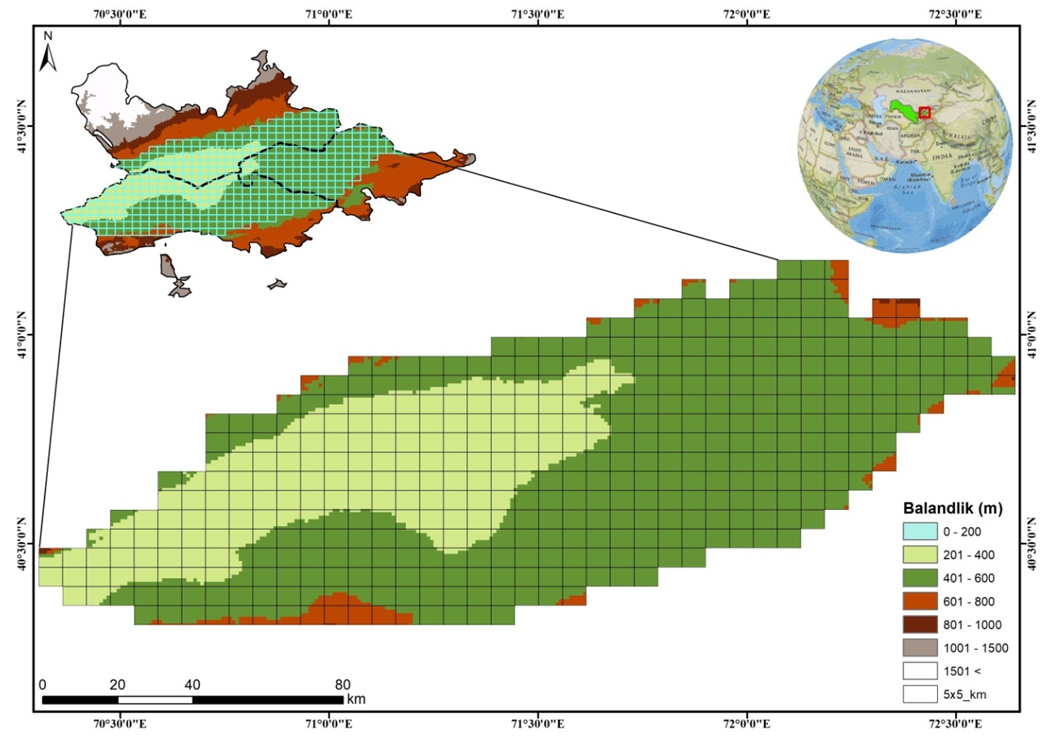 | Figure 1. Central Fergana Botanical and Geographical District |
3. Analysis and Results
- During the 2024–2025 field season, we surveyed the flora of the central Fergana Valley–specifically the Qayroqqum, Yozyovon, and Eastern Fergana districts. Combined with the examination of herbarium material from the principal collections (MW, TASH, LE) and a review of the relevant literature, these efforts documented four species of the genus Astragalus.Globally, recent multispecies studies have tended to emphasize the discovery of new taxa together with analyses of phytochemistry, morphology, and ontogeny, whereas the geography of species, their natural resource base, and current conservation status have been addressed less extensively. Species of Astragalus in particular often require conservation attention. This contribution provides concise accounts of the Astragalus species recorded from the flora of the central Fergana Valley, accompanied by brief notes on distribution and mapped occurrences.Astragalus rubellus Gontsch., 1941, Bot. Mater. Gerb. Bot. Inst. Komarova Akad. Nauk S.S.S.R. 9: 94. Holotype: Uzbekistan, Systema fl. Syrdarja, Distr. Ferghana, in arenis mobilibus prope Kara-kalpak, 1.V.1913, fl. et fr., G. I. Dolenko 4167 (LE). (Fig. 3F)This species is endemic to the Fergana Valley and is associated primarily with sandy desert habitats [7]. Based on our 2024–2025 fieldwork and the study of available herbarium specimens, A. rubellus is confirmed from the following localities (herbarium label wording retained where appropriate):– Distr. Kokand, near Kyzyl-tola, Dauduk, 23.VI.1913, Minkwitz 884 (LE);– Margelan district, Kara-Kalpak, 01.V.1913, Dessiatoff 383, 314 (LE);– Kuyganyar irrigation district, ca. 6 km W of Yaka-Duka village, 16.VII.1928, Ioffe 706 (TASH);– Distr. Margelan, Yazyavan, 13.V.1952, Arifkhanova 289 (LE);– Road between Margilan and Andijan, vicinity of Kora village, 19.V.1952, Arifkhanova & Gringof 497 (TASH);– Yazyavan steppe, Uroch. Sofa, ca. 4 km NW, 13.V.1952, Arifkhanova & O. Gringof 289 (TASH);– Yazyavan district, Talkuduk massif, 26.IV.1953, Saidaliev s.n. (TASH);– Yazyavan district, Stalinabad, 19.V.1957, Saidaliev s.n. (TASH);– Fergana Region, Toshloq district, Takalik-2 village, small sandy desert, 09.V.2024, I. Sharipov, 40.739344, 71.649421;– Fergana Region, Yozyovon district, Yozyovon Natural Monument area, 21.IV.2024, I. Sharipov, 40.674586, 71.487581;– Namangan Region, Mingbulok district, Alami village, Karakalpak desert, 05.V.2024, I. Sharipov;– Andijan Region, Ulug‘nor district, sand dunes near Haydarabad village, 28.IV.2024, I. Sharipov. (Fig. 2)
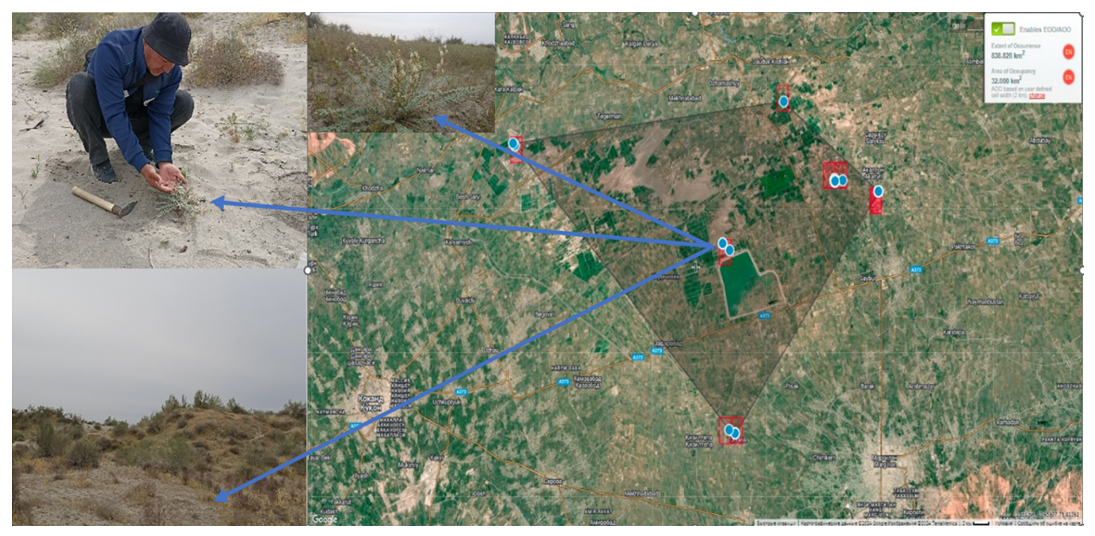 | Figure 2. GeoCAT map of the distribution of the species Astragalus rubellus Gontsch |
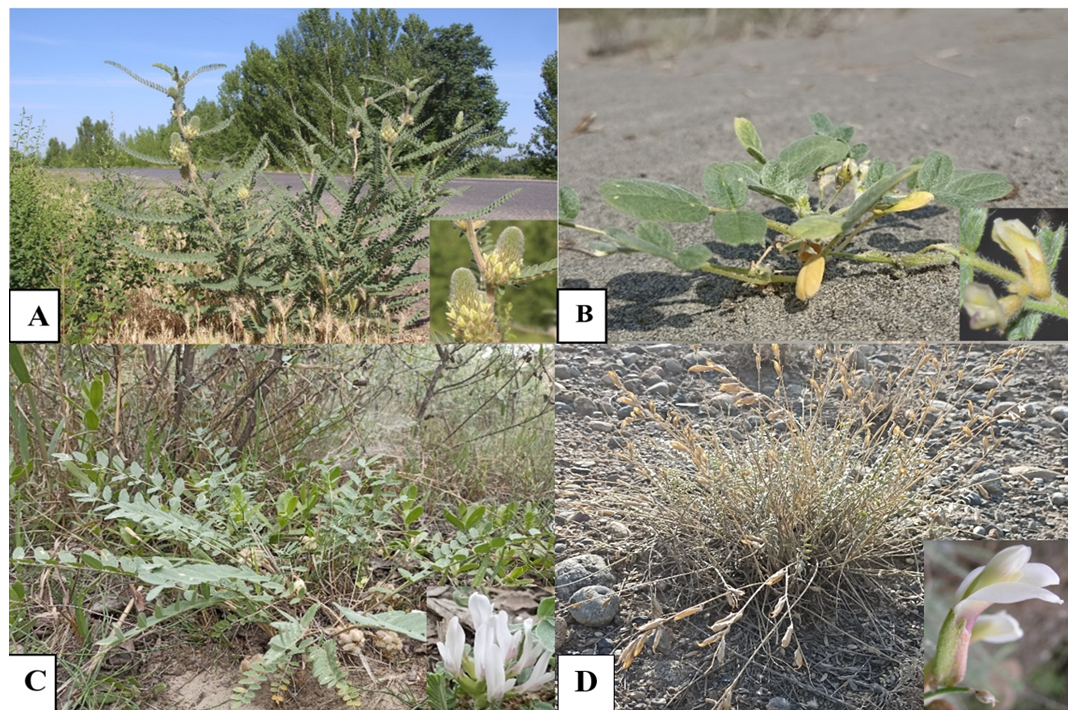 | Figure 3. A-A.alopecias; B-A.arpilobus; C- A.lasiopetalus; D-A.namanganicus; Astragalus lasiopetalus Bunge in Index Seminum (TU, Dorpatensis) 1839: vii (1841) |
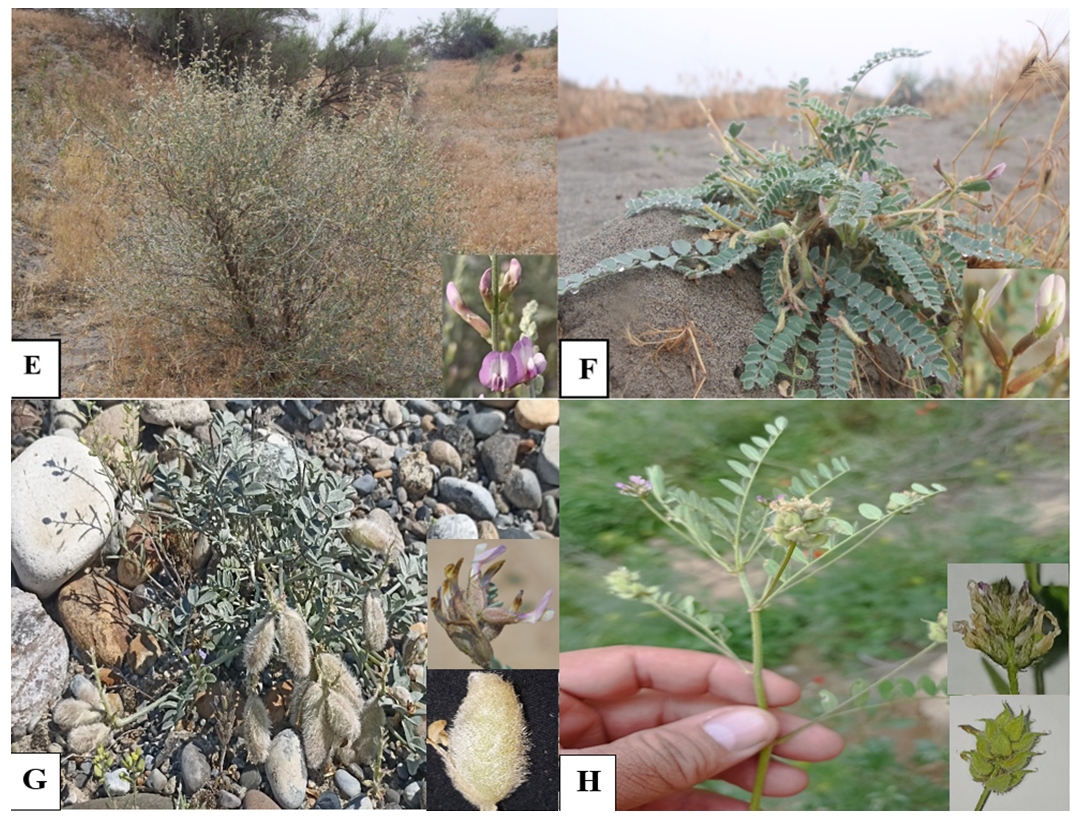 | Figure 4. E- A.chodshenticus; F-A.rubellus; G-A.Ferganensis; H-A.filicaulis |
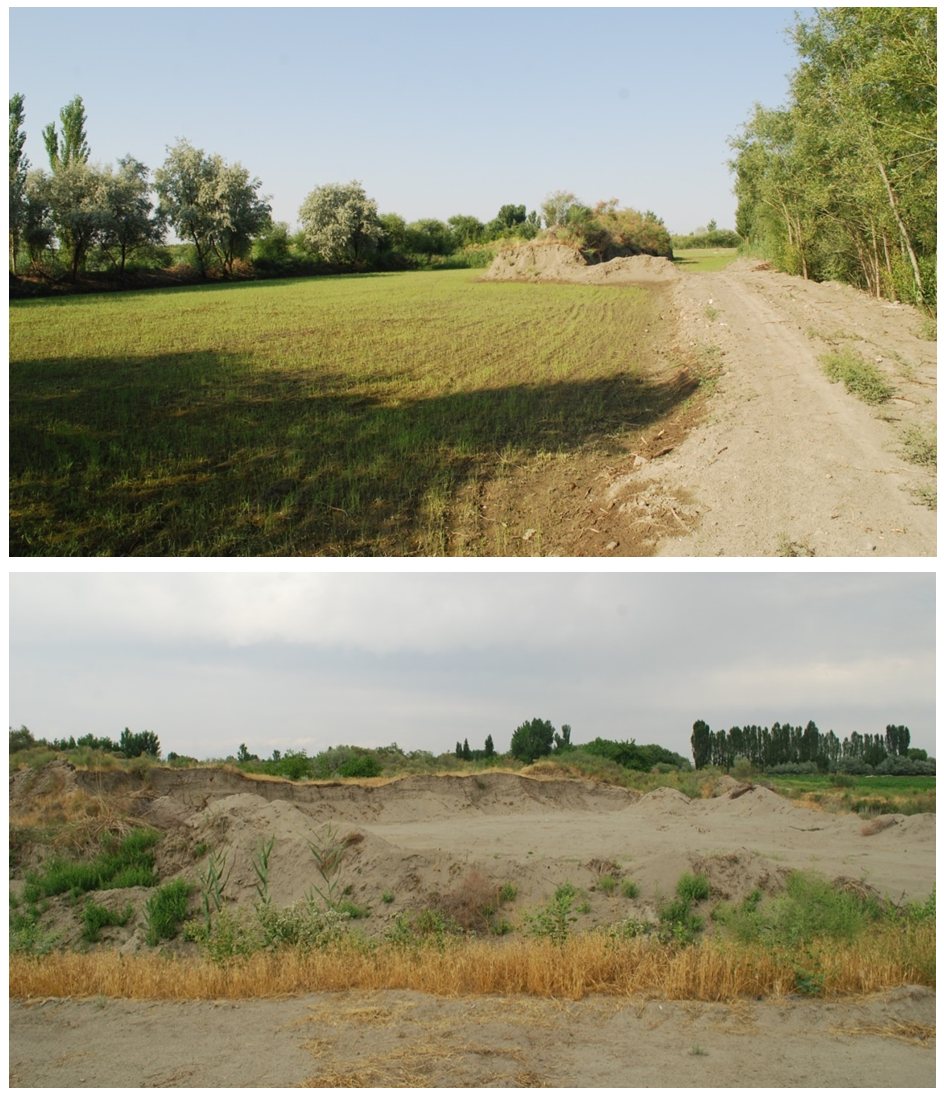 | Figure 5. Development of the sands of the Fergana Valley |
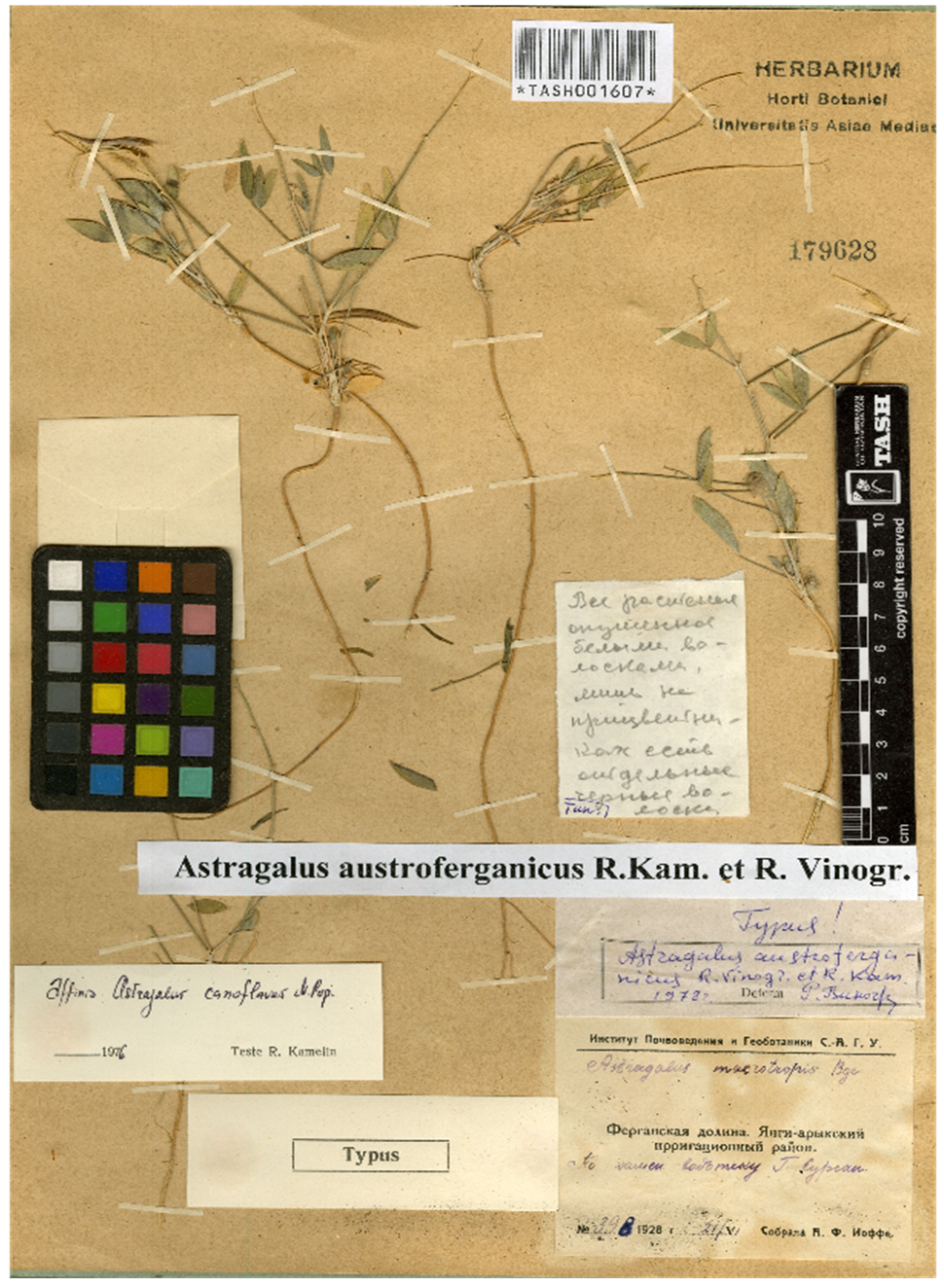 | Figure 6. Herbarium type specimen of Astragalus austroferganicus (TASH) |
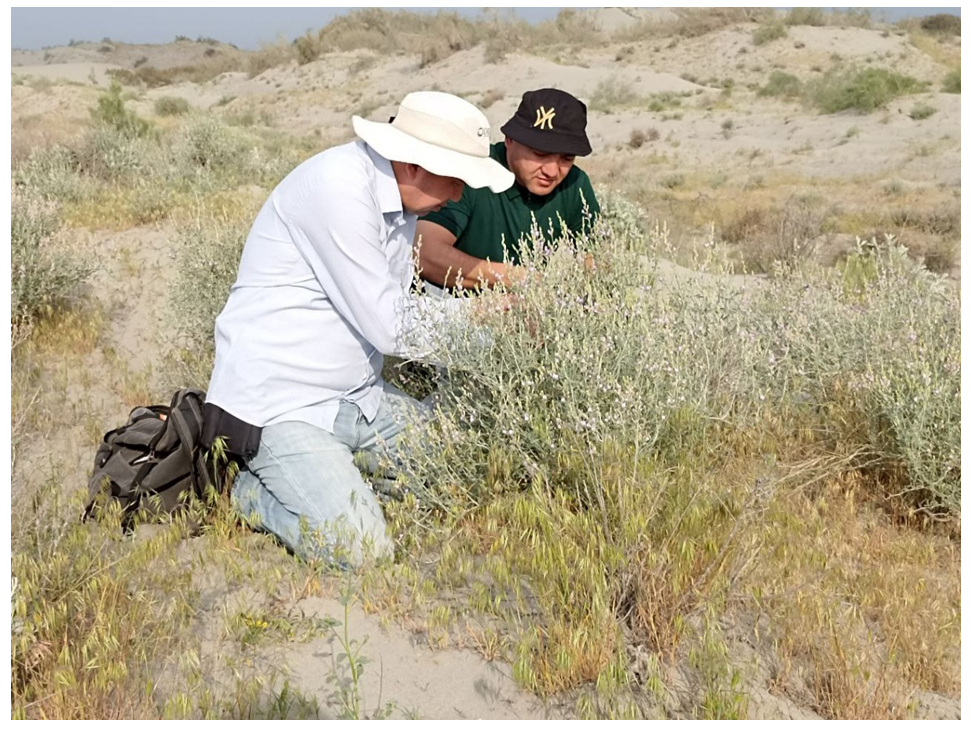 | Figure 7. Astragalus ammodendron Bunge (Yazyavon Natural Monument) |
4. Discussion
- The integrated dataset–spanning 2024–2025 field surveys, verified vouchers from MW, TASH and LE, and curated literature–clarifies the distribution and habitat preferences of several Astragalus taxa within the central Fergana Valley. Sandy substrates associated with the Qayroqqum–Yozyovon system emerge as the principal habitat template, while roadside and field-margin microhabitats also contribute substantively to the record set. Biogeographic patterns and habitat partitioning. The focal assemblage exhibits a gradient from habitat generalists to narrow psammophytes. Astragalus alopecias is widespread and tolerant of disturbed, humus-enriched roadside soils, whereas A. rubellus–endemic to the Fergana Valley–shows a strong association with mobile or semi-fixed sands, consistent with prior regional syntheses [7,1]. Records of A. arpilobus and A. chodshenticus further underscore the importance of dune and proto-dune mosaics. Elevational notes (ca. 350–400 m for A. cognatus; ca. 650–800 m for A. filicaulis) suggest fine-scale partitioning along moisture and substrate-texture axes within an otherwise low-relief desert–steppe ecotone. This partitioning has practical implications: conservation planning should treat “sandy desert” not as a single habitat but as a set of micro-habitats (mobile dunes, stabilized dunes, interdune flats, sandy fallows) supporting different Astragalus guilds.Conservation signals. Multiple lines of evidence indicate heightened vulnerability in the study landscape: long-term agricultural development, irrigation infrastructure, sand extraction, off-road traffic, and settlement expansion collectively reduce suitable psammophytic patches and increase fragmentation. GeoCAT outputs (mapped for A. rubellus) highlight spatial restriction and clumped occurrences; although formal IUCN categories require quantitative Extent of Occurrence/Area of Occupancy estimates, the observed pattern is consistent with a narrow-ranged taxon potentially sensitive to further habitat loss. Given that several Astragalus taxa in Uzbekistan are red-listed and that herbarium-based rarity signals can underestimate true risk when sampling is sparse [9,7], precautionary management is warranted.Taxonomic and nomenclatural notes. The treatment of A. arpilobus (including the orthographic variant A. harpilobus) exemplifies persistent nomenclatural and identification challenges in large, morphologically complex genera. Historical labels often use legacy toponyms or imprecise locality strings, complicating georeferencing; likewise, diagnostic characters (e.g., pod pubescence, calyx teeth, indumentum density) can vary with substrate and phenology. Future work should pair updated regional keys (sensu Kamelin, 1981) with molecular markers to test species limits and to detect possible cryptic diversity within psammophytic clades.Data completeness and bias. The record set blends historical vouchers (1928–1974) with recent observations (2021–2025). While this temporal breadth is a strength, it also embeds biases: early collections cluster along irrigation canals and road networks, and modern records are denser near accessible dunes and protected units (Yozyovon Natural Monument). Following evidence-based guidance on sampling sufficiency [9], systematic resurveys should target under-sampled dune fields, interfluves, and privately managed sandy fallows to improve detection probabilities and trend inference.Regional context. POWO/IPNI range summaries show that several documented species extend beyond the Fergana Basin into Xinjiang and the western Tian Shan forelands, whereas others (e.g., A. rubellus, A. austroferganicus) appear locally restricted. Peripheral or patch-center populations within Fergana may harbor distinct genetic diversity due to isolation by habitat; targeted population-genetic work would clarify whether central Fergana functions as a refugial “island” for psammophytes or as a corridor along the Syr Darya sands.Management recommendations. In the near term, (i) designate micro-reserves within the Yozyovon/Qayroqqum dune complex that capture mobile–fixed dune transitions; (ii) regulate sand extraction and off-road traffic in occupied patches; (iii) integrate Astragalus hotspots into local land-use plans (buffering irrigation expansions and settlement); (iv) establish seed banks and living collections for narrowly distributed taxa, prioritizing A. rubellus and A. austroferganicus; and (v) institutionalize a five-year monitoring cycle using fixed photo-points and plot-based occupancy to quantify population trends. These steps align with Uzbekistan’s red-listing practice and broader IPA/KBA principles [1,7].Outlook. The updated distributional evidence provides a practical baseline for conservation action and for hypothesis-driven research on psammophytic plant resilience in arid Central Asia. By combining repeated field surveys, voucher reinterpretation, and geospatial analysis across the dune mosaic, future work can move from presence-only mapping toward robust demographic assessments and threat attribution–essential for prioritizing limited conservation resources in this rapidly changing landscape.
5. Conclusions
- As a result of the fact that the Central Fergana Botanical and Geographical District has been under strong anthropogenic influence for the past 80 years, the number of plant species naturally distributed in the district has been decreasing. During the field research conducted in the central part of the valley in 2024-2025, it was found that the Astragalus genus of the Fabaceae family has also been preserved in limited numbers. Since the species of this genus are mainly found on sandy, stony-gravelly soils, the development of natural areas puts the preservation of these species in doubt.
 Abstract
Abstract Reference
Reference Full-Text PDF
Full-Text PDF Full-text HTML
Full-text HTML